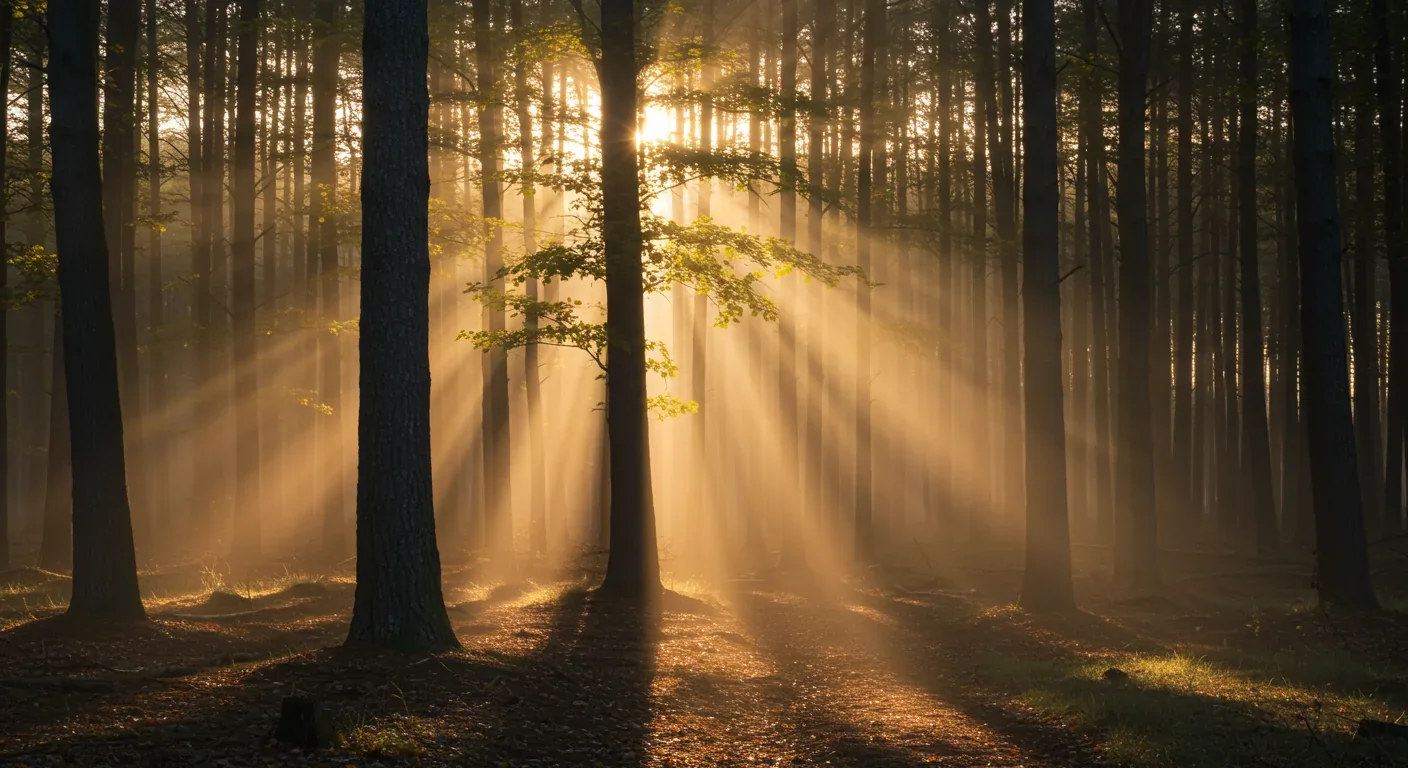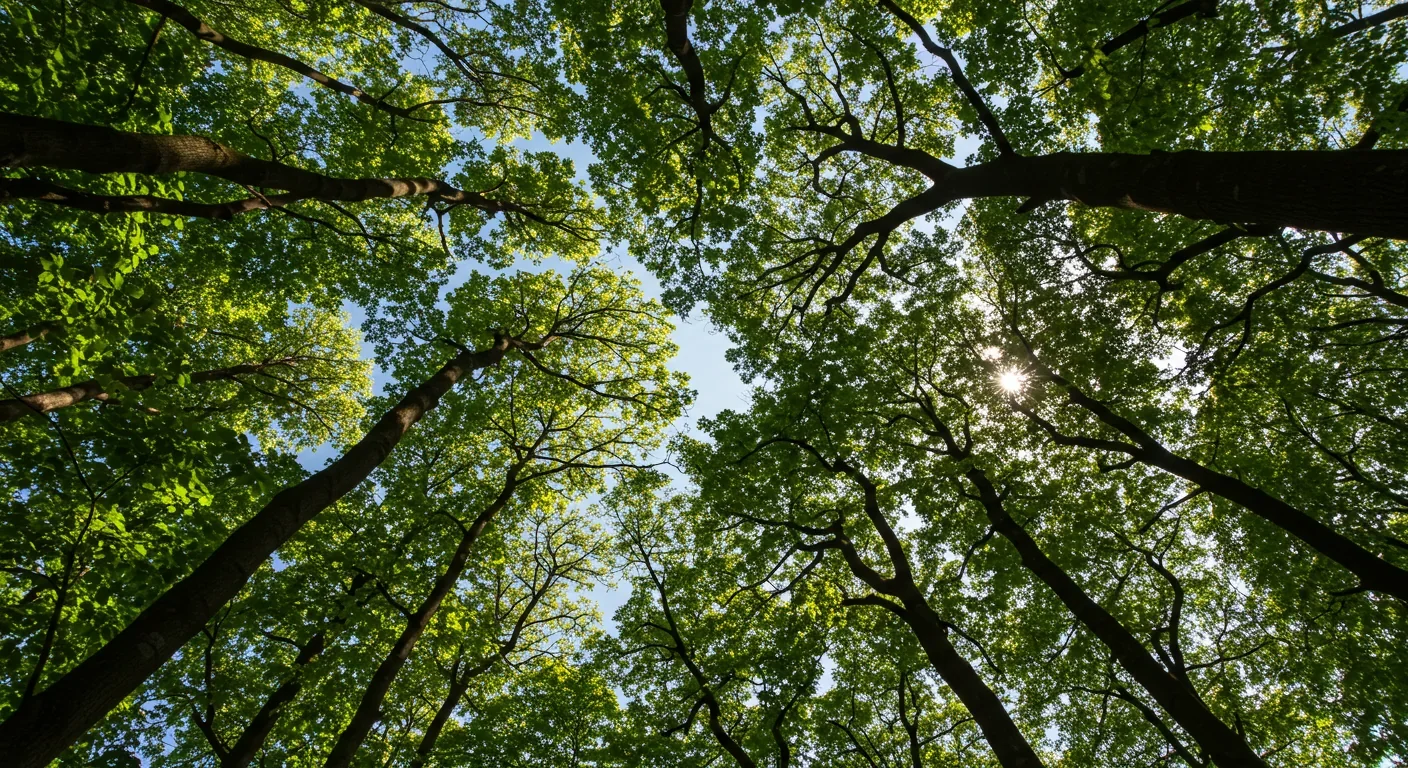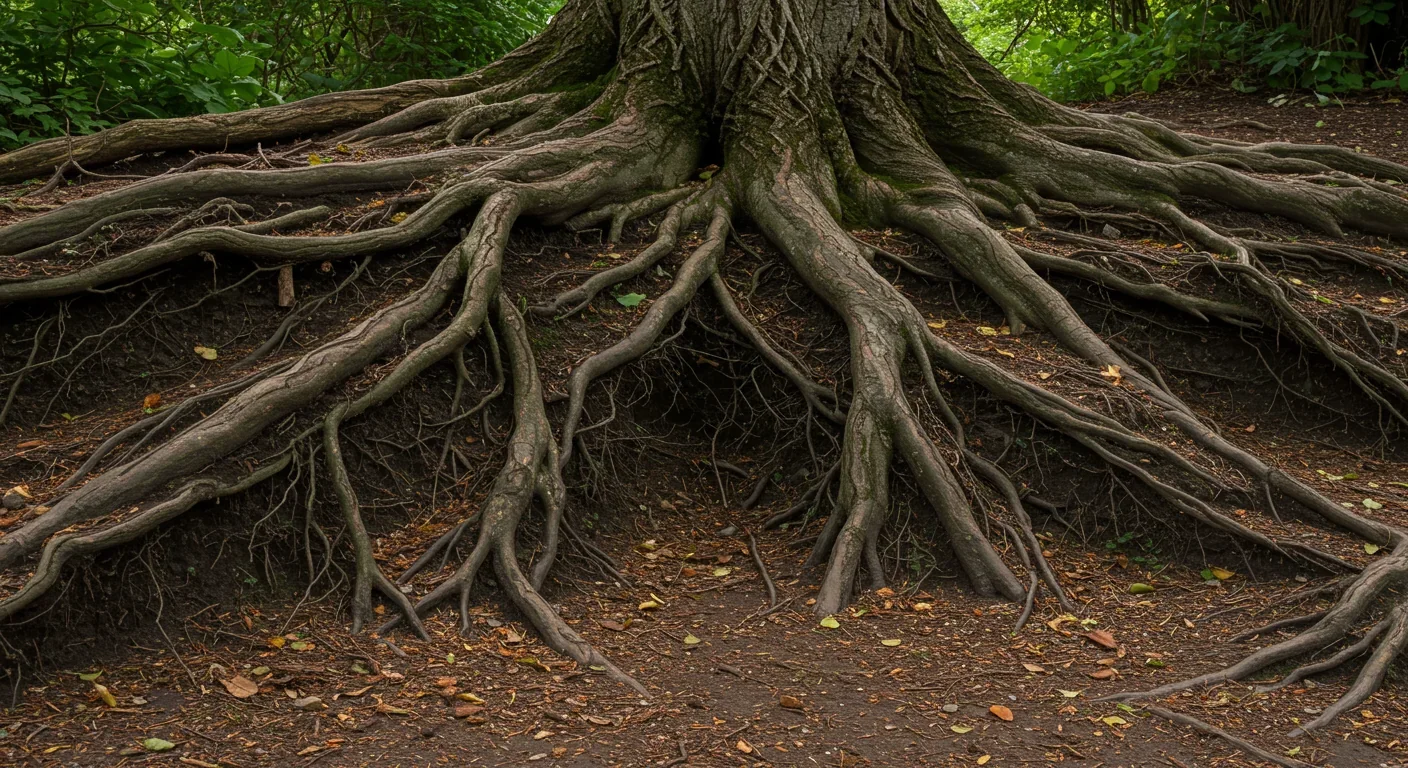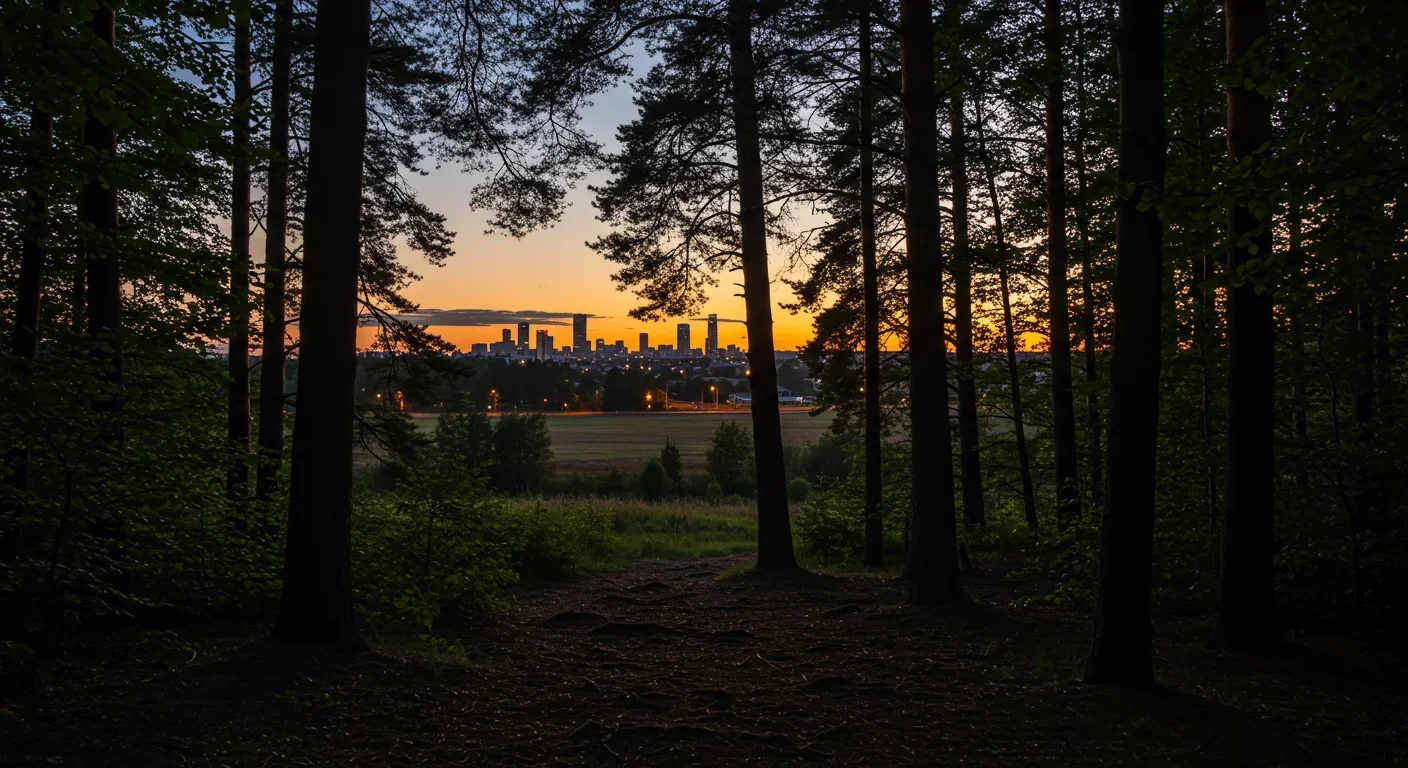How Soft Corals Weaponize Their Symbiotic Algae

TL;DR: Forests operate as synchronized living systems with molecular clocks that coordinate metabolism from individual cells to entire ecosystems, creating rhythmic patterns that affect global carbon cycles and climate feedback loops.

Walk into a forest at dawn, and you might think you're witnessing a simple awakening—birds stirring, dew evaporating, leaves turning toward the light. But something far more profound is happening beneath the surface. Every tree, every root system, every chloroplast is responding to an ancient internal timekeeper, a molecular clock that has been ticking for millions of years. These aren't just individual organisms responding to daylight. They're synchronized living systems, coordinating their metabolism across entire ecosystems in ways scientists are only beginning to understand.
Recent discoveries in chronobiology—the study of biological rhythms—reveal that forests operate as vast, interconnected networks governed by circadian clocks. These internal timekeepers regulate everything from photosynthesis and respiration to water transport and carbon cycling, creating forest-wide rhythms that pulse through the canopy and into the soil. The implications stretch far beyond basic biology: these rhythms directly impact global carbon budgets, climate feedback loops, and our understanding of how ecosystems respond to environmental change.
At the heart of every tree cell lies a remarkably sophisticated biological clock. Unlike the mechanical timepieces humans invented, these circadian systems are built from proteins that turn genes on and off in precise cycles, creating oscillations that repeat roughly every 24 hours—even when isolated from external cues.
The core mechanism centers on what scientists call transcription-translation feedback loops. In plants, key proteins like CCA1, LHY, and TOC1 form the molecular gears of this clock. During the day, CCA1 and LHY accumulate and suppress the production of evening genes. As their levels decline toward dusk, TOC1 and other evening proteins rise, eventually triggering the morning genes to restart the cycle. It's a self-sustaining oscillator that maintains its rhythm even in constant darkness.
What makes this system particularly elegant is how it integrates with the cell's energy-producing organelles. Chloroplasts and mitochondria—the powerhouses responsible for photosynthesis and respiration—don't just respond passively to the clock. They're actively entrained by it, coordinating their metabolic activities to match the daily rhythms of light and energy availability.
More than 2,100 genes in tree roots and 2,500 in needles show circadian oscillations—meaning the entire organism, from canopy to root tip, operates on synchronized time.
Research on Chinese pine has revealed that this coordination extends throughout the entire plant. Scientists discovered that not only do pine needles exhibit clear circadian patterns, but root systems deep underground—where no sunlight penetrates—also maintain rhythmic gene expression. More than 2,100 genes in roots and 2,500 in needles show circadian oscillations. This means the entire organism, from canopy to root tip, operates on synchronized time.

The real revolution in our understanding came when scientists stopped looking at individual trees and started examining forests as systems. Using geostationary satellites that can photograph the same location every 15 minutes, researchers tracked photosynthesis rates across entire subtropical forests throughout the day. What they found was striking: forests don't just gradually increase photosynthesis as the sun rises and gradually decrease as it sets. Instead, they show coordinated patterns with pronounced peaks in late morning, followed by consistent midday depressions, regardless of cloud cover or minor weather fluctuations.
This coordination suggests that individual trees aren't simply reacting to their immediate environment. They're following an internal schedule that has evolved to anticipate daily patterns. When millions of trees synchronize their metabolism this way, it creates measurable pulses of carbon dioxide exchange that ripple through the atmosphere—a planetary heartbeat driven by microscopic molecular clocks.
The mechanism behind this forest-wide synchronization involves multiple layers of coordination. At the cellular level, light-sensitive proteins called cryptochromes and phytochromes detect both the intensity and wavelength of incoming light, particularly blue light around 480 nanometers. This information resets the clock each day, ensuring it stays aligned with local solar time.
But light isn't the only synchronizing signal. Root systems that never see daylight maintain circadian rhythms through temperature cues and chemical signals transmitted from the canopy. This means trees can coordinate metabolism between organs separated by dozens of meters, creating a unified temporal architecture for the entire organism.
The synchronized metabolism of forests has profound consequences for Earth's carbon cycle. Every day, forests collectively absorb billions of tons of carbon dioxide through photosynthesis and release it back through respiration. The timing and coordination of these processes—governed by circadian regulation of gas exchange—directly affects atmospheric carbon concentrations and climate feedback loops.
During the morning hours, as circadian clocks ramp up photosynthetic gene expression, forests become powerful carbon sinks. Satellite data reveals that this morning peak is highly predictable and can be modeled with 86% accuracy using machine learning algorithms trained on environmental variables. This precision suggests that forest carbon uptake isn't simply proportional to available sunlight—it's orchestrated by internal timing mechanisms that optimize when and how efficiently carbon is fixed.
"The clock drives temporal gene expression with physiological consequences, such as gas exchange, from individual to ecosystem scales."
— Research published in Frontiers in Plant Science
The midday depression observed in forest photosynthesis presents a fascinating puzzle. While some of this reduction can be attributed to heat stress and photoinhibition, the consistency of the pattern across different conditions points to circadian regulation as a contributing factor. Trees may be programmed to reduce photosynthetic activity during the hottest part of the day, conserving resources and avoiding oxidative damage.
This circadian control extends to respiration as well. At night, when photosynthesis ceases, trees continue to respire, breaking down stored sugars to power cellular maintenance and growth. The rate of this nighttime respiration isn't constant—it follows circadian patterns that can persist even when environmental conditions remain stable. This means forests "breathe out" carbon dioxide in rhythmic pulses that contribute to the daily atmospheric CO2 cycle measurable from space.

One of the most elegant aspects of forest circadian systems involves the intricate dance between biological clocks and cellular redox state—the balance between oxidizing and reducing chemical conditions within cells. This relationship creates a feedback loop that both drives and responds to the circadian clock.
During photosynthesis, chloroplasts produce reactive oxygen species (ROS) as byproducts of light harvesting. These molecules, while potentially damaging, also serve as signaling agents. Trees have evolved circadian control of antioxidant enzymes that neutralize ROS, with these protective systems peaking at specific times of day when oxidative stress is highest.
The genius of this system is its self-reinforcing nature: the clock controls when antioxidant defenses are deployed, while the redox state itself can feed back to adjust clock timing. When trees experience acute stress that overwhelms their redox balance, this can actually reset their circadian clocks, triggering a cascade of protective responses timed to the new environmental reality.
This redox-circadian coupling may explain how forests maintain metabolic coordination even under changing conditions. Chlorophyll fluorescence measurements—which indicate photosynthetic efficiency—show clear daily rhythms that correlate with both clock gene expression and ROS production. It's a molecular conversation between energy production, stress response, and time-keeping that ensures cellular processes stay synchronized.
For circadian clocks to be useful, they must stay aligned with the external world. This synchronization happens through a process called entrainment, where environmental signals reset the clock each day to compensate for any drift from a perfect 24-hour cycle.
Light is the primary entraining signal for forest canopies. Photoreceptor proteins in leaf cells detect the onset of dawn, triggering immediate changes in clock gene expression that reset the molecular oscillator. The system is exquisitely sensitive—even low levels of blue light can produce significant phase shifts. This sensitivity allows trees to track seasonal changes in day length and anticipate the appropriate timing for growth, dormancy, and reproduction.
Root systems deep underground maintain circadian rhythms through temperature cues and chemical signals from the canopy, coordinating metabolism across dozens of meters without ever seeing sunlight.
But forests experience light in complex ways. The forest floor receives flickering, filtered sunlight quite different from the steady illumination of the canopy. Lower branches experience partial shading from above. Yet somehow, trees maintain coordination across these varied light environments. Research suggests they accomplish this through multiple entrainment pathways: direct photoreception by individual leaves, systemic signals transmitted through vascular tissue, and temperature cues that correlate with the light-dark cycle.
Temperature serves as a secondary but crucial entraining signal, especially for root systems that never experience light directly. Soil temperature fluctuates daily as heat penetrates from the surface, creating a thermal rhythm that roots can detect and use to maintain circadian synchrony with above-ground tissues. In coniferous species like Chinese pine, temperature cues become particularly important during autumn dormancy induction, when shortening photoperiods trigger growth cessation.
This multi-modal entrainment makes forest circadian systems remarkably robust. Even when one signal becomes unreliable—cloud cover obscuring light, or unseasonable temperatures—other cues can maintain synchronization. It's a resilient architecture evolved over millions of years of adaptation to Earth's variable environments.

The very resilience that has allowed forest circadian systems to thrive faces unprecedented challenges from rapid climate change. As global temperatures rise and weather patterns destabilize, the environmental signals that forests have relied upon for synchronization are becoming less predictable.
Rising temperatures don't just make forests hotter—they alter the timing and reliability of temperature cues that entrain circadian clocks. When spring arrives earlier, trees may trigger leaf-out before the risk of late frosts has passed, exposing vulnerable new growth to damage. When autumn warmth lingers, the temperature signals that initiate dormancy may arrive too late, leaving trees unprepared for sudden cold snaps.
The mismatch between internal clock timing and actual environmental conditions creates what researchers call "circadian disruption"—a state where biological rhythms fall out of sync with external reality. In individual organisms, this can reduce fitness and productivity. At the ecosystem scale, the consequences could be severe. If trees across a forest experience circadian disruption simultaneously, the coordinated carbon exchange that characterizes healthy forests could degrade into metabolic chaos.
"Both needles and roots have rhythmic oscillatory genes, even though the roots could not receive light signals directly."
— Study on Chinese pine circadian transcription, BMC Plant Biology
Drought presents another circadian challenge. Water stress affects both photosynthesis and respiration, but it also influences the redox state that feeds back to the circadian clock. Prolonged drought could therefore disrupt not just tree water balance but also their fundamental sense of time, with cascading effects on growth, reproduction, and carbon cycling.
Early evidence suggests these disruptions are already occurring. Studies comparing historical and recent measurements of forest gas exchange show subtle shifts in the timing of peak photosynthesis at some sites, potentially indicating circadian phase changes in response to warming. The long-term consequences remain uncertain, but the possibility that climate change could desynchronize forests at the molecular level represents a troubling new dimension of ecosystem risk.
While climate change gradually shifts the environmental cues forests rely upon, artificial light creates more immediate disruptions. The ecological consequences of light pollution have focused primarily on animals—disoriented migratory birds, confused sea turtle hatchlings, altered predator-prey dynamics. But plants, including trees, are also affected by the growing intrusion of artificial light into natural environments.
Forests near urban areas and major roadways experience significant nighttime illumination from streetlights, buildings, and passing vehicles. This light, particularly the blue-rich emissions from LED sources, is precisely the wavelength range that plant photoreceptors detect most strongly. Even relatively low levels of artificial light can affect circadian entrainment in plants.
The impacts are subtle but potentially significant. Continuous low-level nighttime illumination can alter the expression of clock genes, shifting the phase of circadian rhythms or even suppressing oscillations entirely in extreme cases. For individual trees, this might mean altered patterns of carbon allocation, changes in seasonal timing, or reduced stress resilience.
At the forest margin where light pollution is strongest, these individual-level effects could aggregate into ecosystem impacts. If trees at forest edges experience circadian disruption while interior trees maintain normal rhythms, the coordination that characterizes forest metabolism could break down. Edge trees might initiate spring growth earlier, experience altered frost hardiness, or show different responses to pest outbreaks compared to their interior counterparts.
Even low levels of blue light from LED streetlights can disrupt tree circadian clocks near urban areas, potentially breaking the metabolic coordination that forests depend on.
The phenomenon also raises questions about forest management near developed areas. If artificial light reduces the fitness or alters the phenology of edge trees, forest buffers might need to be wider than currently assumed to protect interior ecosystems. Light-shielding measures that direct illumination downward rather than outward could become important conservation tools in periurban forests.

Understanding forests as synchronized temporal systems rather than collections of individuals opens new approaches to forest management and conservation. If tree health and ecosystem function depend on maintaining circadian coordination, then protecting the environmental cues that enable this synchronization becomes a conservation priority.
One immediate application involves forest carbon accounting. Current methods for estimating forest carbon uptake typically rely on daily or monthly averages that smooth over temporal variation. But if circadian rhythms create predictable patterns in when forests most actively sequester carbon, accounting methods that incorporate these rhythms could be substantially more accurate. The satellite-based approaches that can track forest photosynthesis hourly throughout the day represent a step in this direction.
Forest restoration efforts could also benefit from chronobiological insights. When planting new forests or managing recovering ones, foresters might select for tree populations adapted to the local light and temperature regimes that will entrain their circadian clocks most effectively. In a changing climate, this could mean choosing provenances from slightly warmer regions that have already adapted to conditions the planting site will experience in coming decades.
The timing of forest management interventions matters too. Thinning, prescribed burning, and other treatments alter the light environment experienced by remaining trees. Understanding how these changes affect circadian entrainment could help optimize treatment timing and intensity. For example, thinning that dramatically increases light to understory trees might temporarily disrupt their circadian systems until they adapt to the new conditions, with potential short-term impacts on growth and stress resilience.
For forests threatened by pests or pathogens, circadian coordination takes on additional significance. Trees with well-synchronized circadian clocks may be better able to mount coordinated defenses, as the timing of defensive compound production often follows daily rhythms. Forest stands where this coordination has been disrupted by edge effects, fragmentation, or environmental stress might be more vulnerable to attack.
For all that researchers have learned about forest circadian systems, fundamental questions remain unanswered. The mechanisms by which individual trees synchronize with their neighbors are still poorly understood. Is the forest-wide coordination observed in satellite data simply the aggregate result of millions of individuals responding to the same environmental cues? Or are there lateral signaling mechanisms—chemical, electrical, or fungal network-mediated—that allow direct communication of temporal information between trees?
The role of mycorrhizal networks in circadian coordination represents a particularly intriguing possibility. These fungal networks physically connect root systems of different trees, facilitating exchange of nutrients, water, and chemical signals. Could they also transmit temporal information, helping forests maintain synchronization even when individual trees experience different micro-environments? The metabolic activity of mycorrhizal fungi themselves likely follows daily rhythms; how these fungal clocks interact with tree clocks in the symbiotic relationship remains unexplored.
Seasonal rhythms and their interaction with daily circadian cycles present another frontier. Trees clearly respond to changing day length, but how do these photoperiodic responses integrate with the daily timekeeping functions of circadian clocks? The dormancy induction observed in conifers involves both circadian and seasonal components, but the molecular mechanisms linking these different temporal scales are only beginning to be characterized.
Understanding these systems becomes even more urgent as climate change accelerates. Can forests adapt their circadian systems rapidly enough to track shifting environmental conditions? Or will the pace of change exceed the adaptive capacity of these molecular timekeepers? Some tree species might possess genetic variation in clock gene function that allows populations to evolve new circadian characteristics within a few generations. Others, particularly long-lived species with slow generation times, might lack this flexibility.
The potential for deliberate management of forest circadian systems raises both opportunities and ethical questions. If we develop the ability to manipulate tree circadian clocks through selective breeding or biotechnology, should we? Enhancing carbon sequestration by optimizing circadian control of photosynthesis sounds appealing, but the ecological consequences of such interventions are impossible to fully predict. The interconnectedness that makes forests function as synchronized systems also means that disruptions could cascade in unexpected ways.
The discovery that forests operate as chronobiologically synchronized systems fundamentally changes how we should think about these ecosystems. For too long, we've conceived of forests primarily in spatial terms—maps of species distributions, measurements of canopy structure, analyses of horizontal and vertical layering. The temporal dimension has been there all along, of course, implicit in seasonal changes and successional dynamics. But the revelation that forests possess intricate molecular timekeeping mechanisms operating at scales from seconds to seasons adds a crucial new dimension to our understanding.
These circadian systems are not peripheral features but core aspects of forest function, integral to carbon cycling, stress response, seasonal adaptation, and long-term resilience. They represent evolution's solution to the fundamental challenge of living on a rotating planet with predictable daily and seasonal rhythms. The sophistication of these solutions—molecular clocks that stay synchronized across millions of cells and between organisms, feedback systems that couple time-keeping to metabolism, entrainment mechanisms that track environmental change while maintaining stable periods—reveals forests as far more than collections of individual trees competing for resources.
"One of the most important cues to entrain circadian rhythms is light."
— Research on light effects on circadian rhythm
As we face the dual challenges of preserving existing forests and restoring degraded ones in a changing climate, this chronobiological perspective offers both new tools and sobering warnings. The tools include improved carbon accounting, better understanding of stress resilience, and insights into how forests might adapt to new environmental conditions. The warnings concern the fragility of circadian coordination in the face of rapid change, the underappreciated impacts of artificial light, and the potential for desynchronization to compound other climate-driven stresses.
Perhaps most importantly, recognizing forests as temporal systems highlights how much we still don't know. Every ecosystem harbors mysteries, but the discovery of pervasive circadian organization in forests suggests we've been missing fundamental aspects of how these systems work. The satellite data showing coordinated metabolic pulses, the molecular evidence of synchronized gene expression from canopy to roots, the intricate coupling of redox state to time-keeping—these findings are recent, and they point toward even deeper layers of organization we're only beginning to glimpse.
The forests have been keeping time for millions of years, their molecular clocks ticking through ice ages and warm periods, mass extinctions and ecological recoveries. Whether they can maintain this ancient rhythm through the unprecedented changes humanity is imposing on the planet remains the crucial question. The answer will depend partly on their inherent resilience, partly on how quickly climate conditions stabilize, and partly on whether we can develop forest management approaches that protect not just the spatial structure of forests but their temporal architecture as well.
In the end, forests remind us that life is inseparable from time. The daily dance of proteins, the seasonal surge and recession of growth, the long slow rhythms of succession and maturation—these temporal patterns are as fundamental to forests as the soil they grow in and the air they exchange gases with. Understanding forests as chronobiological systems doesn't diminish their majesty. If anything, it deepens our appreciation for the exquisite complexity of these ecosystems and the elegant solutions that billions of years of evolution have produced for the simple problem of keeping time on a spinning world.

Lunar mass drivers—electromagnetic catapults that launch cargo from the Moon without fuel—could slash space transportation costs from thousands to under $100 per kilogram. This technology would enable affordable space construction, fuel depots, and deep space missions using lunar materials, potentially operational by the 2040s.

Ancient microorganisms called archaea inhabit your gut and perform unique metabolic functions that bacteria cannot, including methane production that enhances nutrient extraction. These primordial partners may influence longevity and offer new therapeutic targets.

CAES stores excess renewable energy by compressing air in underground caverns, then releases it through turbines during peak demand. New advanced adiabatic systems achieve 70%+ efficiency, making this decades-old technology suddenly competitive for long-duration grid storage.

Human children evolved to be raised by multiple caregivers—grandparents, siblings, and community members—not just two parents. Research shows alloparenting reduces parental burnout, improves child development, and is the biological norm across cultures.

Soft corals have weaponized their symbiotic algae to produce potent chemical defenses, creating compounds with revolutionary pharmaceutical potential while reshaping our understanding of marine ecosystems facing climate change.

Generation Z is the first cohort to come of age amid a polycrisis - interconnected global failures spanning climate, economy, democracy, and health. This cascading reality is fundamentally reshaping how young people think, plan their lives, and organize for change.

Zero-trust security eliminates implicit network trust by requiring continuous verification of every access request. Organizations are rapidly adopting this architecture to address cloud computing, remote work, and sophisticated threats that rendered perimeter defenses obsolete.